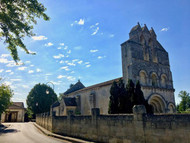Why you should try Lalande de Pomerol wine
Posted by Tom Mullen on 1st Nov 2017
Tom Mullen on the tourist attractions of Lalanade de Pommerol and why it's wines offer great value . Read on for the full article or just try Vieux Chateau Gachet
By Tom Mullen, www.forbes.com View Original August 15th, 2017
After driving north from the riverside city of Libourne in southwest France, you will see signs pointing right toward the towns of Pomerol and Saint-Émilion, and left to the town of Lalande de Pomerol. I took a left.
At the entrance to this town—with a population of less than 700—a sign boasts that vines have been cultivated regionally here since the 12th century. The town is sleepy and peaceful with narrow roads. Surrounding vineyards are shadowed by small and dense tree groves.
This town formed a thriving hospitality hub in the 13th century. Crusaders on their way to or from the east could rest and recuperate, while pilgrims traveling south and west to Spain’s Santiago de Compostela could attend mass, drink sacramental wine and enjoy a respite from long days of travel on foot. Their hosts at Lalande de Pomerol were members of the Order of the Knights of Saint John of Jerusalem (which later moved to a Mediterranean isle and rebranded itself as the Sovereign Order of Malta).
Geographically, Lalande de Pomerol sits north of the wine region of Pomerol, which in turn sits north of the Saint-Émilion wine appellation. This entire cluster of vinelands (just north of the Dordogne River) is located within a triangle drawn between the cities of Bordeaux, Blaye and Bergerac and forms part of the agriculturally bustling and traditionally bucolic heart of much of Bordeaux’s ‘right bank’ wine country.
Since the time of Romans, proximity to riverside commerce helped local vineyards prosper. In the early 13th century, nearby Libourne was established as a port city on the Dordogne River and soon became a regional trade hub for wood, salt and wine (the town square has held bustling markets three times a week for the past six centuries). The Dordogne still provides waterway access westward to Bordeaux city and east to the castle-dappled valleys of the Perigord.
With an area of 2,700 acres (1,100 hectares) with approximately 160 plus wine growers, the appellation includes two towns: Lalande de Pomerol itself and the hillier town of Néac. The region also homes the Baillis de Lalande de Pomerol, a uniformed ‘vinous brotherhood’ formed in 1985 to promote wine. It was considered important enough to the region’s identity that the first appointed president was an internationally renowned figure—oceanographer Jacques-Yves Cousteau (born in the nearby town of Saint-André-de-Cubzac).
Red wines here are made from four grapes. Merlot is dominant, while Cabernet Franc, Cabernet Sauvignon and Malbec often form less than 30% of the total balance of blends. The flat and sandy gravel soils of Lalande de Pomerol historically produced wines of diverse but inconsistent quality—which is one reason they gained lesser renown than wines from Pomerol to the south—across the Barbanne River. Their soils also differ slightly.
“Mostly in Lalande you have a mixture of sand, clay and gravel, whereas in Pomerol you have mostly gravels, clay and also—unique to Pomerol—what is called in French crasse de fer, which are little particles of iron,” explained Charlotte Robin, a wine guide at Château Siaurac.
In the past decades acquisitions and investments within the Lalande de Pomerol appellation (originally designated in 1954) reflect the growing respect for the future potential of local wines. The property now known as La Fleur de Boüard was purchased by Hubert de Boüard (of renowned Château Angélus within Saint-Émilion) almost two decades ago. More recently, the owners of Château Latour purchased a minority stake in family-owned Château Siaurac three years ago. Yet unlike in neighboring appelations, the price for wines here has not yet soared.
“For wine, prices are not increasing compared to the price of vineyards,” explained Martial Junquas, winemaker at Château Altimar and a member of the family that owns Château Chatain.
A result is that winemaking techniques, equipment and overall wine quality may be improving faster than the price per bottle escalates. Some wines within this appellation—right now—can be of excellent value.
In summary, more Bordeaux vineyard investment capital may spill over locally to Lalande de Pomerol, further increasing wine quality (although it’s delightful now) and causing prices to rise—perhaps steeply.
Which is a good reason to try it this summer, while the price is still right.
Tom Mullen is a Forbes contributor, and the author of Vino Voices. Follow him on Twitter, at the Vino Voices blog or at Roundwood Press.

